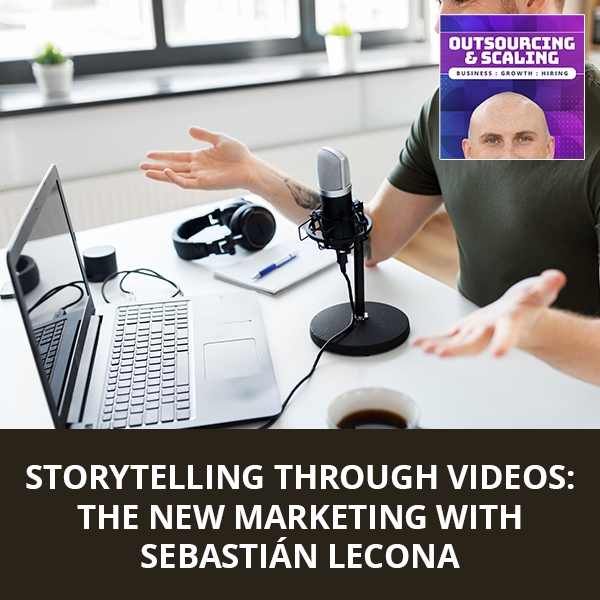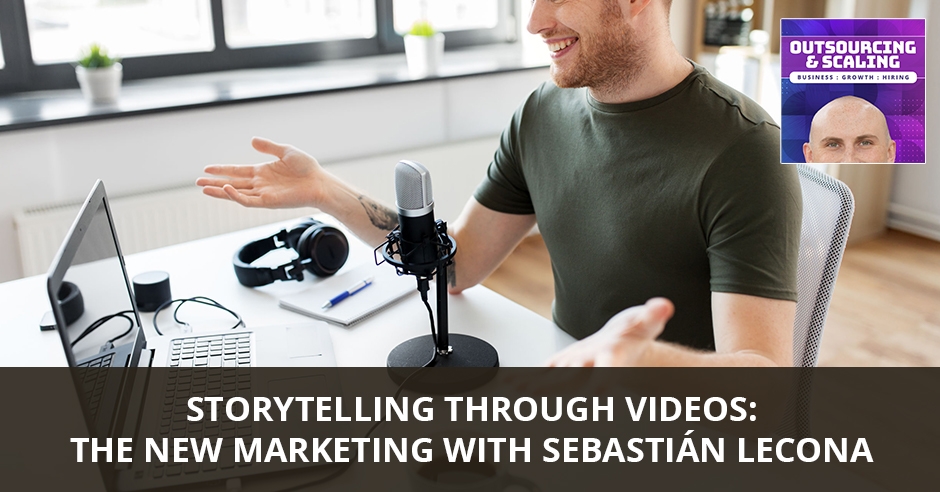


—
Listen to the podcast here:
[smart_track_player url=”https://www.podetize.com/statsapi/www.podetize.com/wp-content/uploads/fileuploads/11-5b145ef137b51b3d1af0633e9305c43d/06/2019/805ddf53bebe6cf14ab3b395e5f74c70.mp3″ title=”Storytelling Through Videos: The New Marketing with Sebastián Lecona” artist=”Nathan Hirsch” image=”https://freeup.net/wp-content/uploads/2019/04/OAS.png” ]
Download the audio file here.
Storytelling Through Videos: The New Marketing with Sebastián Lecona
I have a special guest, Sebastián Lecona. Sebastián, how are you doing?
Thank you for having me, Nathan.
Thanks for being here. We always love to talk to freelancers or former freelancers. As a former motion designer, Sebastián is on a mission to use the power of stories to inspire a better world. He started working on a brand during 2011 while working at TV UNAM doing video branding for national broadcasting. Since 2013, he tapped into his entrepreneurial spirit by helping businesses that wanted to grow their online presence. In 2016, he founded Kataplasma, a brand strategy design consultancy that helps businesses grow by telling inspiring stories on digital media. Sebastián, we’re going to talk all about that. I definitely want to dive into stories. I know that’s a huge part of marketing, but let’s take a step back. Before all of that, even before freelancing, what were you like growing up? Were you a rebel? Did you know you wanted to be an entrepreneur? What kind of student were you?
I’ve always been a rebel. The school wasn’t my best place because I’ve never been good at doing repetitive work. I’ve always been creative. I believe it’s a gift of understanding things very quickly. I thank God for that because I was able to learn in school the concept and understand everything well enough to have always really good exams and that’s what pushed me all the way through school. If it weren’t for that, I probably would never have finished.
Let’s fast forward ahead and talk about freelancing because I’m always curious why someone goes into freelancing. What was so attractive about becoming a freelancer?
Our own brains are wired to understand the world and everything that happens to us through stories.
First of all, I’ve always had a unique way of life. Having a clear schedule and a repetitive routine is that for me. Every day I live it differently. Sometimes I wake up one hour earlier, sometimes I wake up late. The common way of working didn’t work for me. I can do it, but my spirit and my soul got crushed when I had to wake up at a certain time and get out at a certain time to an office and every day the same thing was there for me. That’s why I quickly went out of that world and went into freelancing. That’s how I started freelancing because I needed the freedom to choose what to do in my time. I’ve always known that when I have a deadline, I’m able to get to that point to get everything done on time and on schedule.
How did you get into video and motion design? I feel like that’s not something you just wake up one day and say, “I want to go do motion design.” How did you find that passion?
It’s very funny because I’ve always loved video games and computer animated graphics. I always knew I wanted to be an animator. The funny thing is I didn’t really know how, where, what because it’s actually a very new industry. In Mexico, there wasn’t even a school to learn animation when I had to go into college. That’s something so new that I had to pioneer in my country on that. It’s funny because I’ve always learned from the internet. Since I was twelve years old, I started learning about Flash. That was my first approach to animation. I discovered a couple of shows on YouTube that was done on Flash and I was like, “What is this amazing world? I want to learn more.” I started looking for tutorials. I got the programs and I started learning. I even managed to talk with my computer teacher and I was like, “I’ll teach you Flash so you can teach to my other classmates, but let me use the time in the classroom to learn more so I can develop these skills.” She was happy, I was happy, and it was fun. After that, I kept learning all the programs and Photoshop, After Effects and everything through the internet. Many years later, I got to study the fundamentals of design.
What’s one thing that people wouldn’t know? Like me, I know very little about video even though I now have a podcast and a YouTube channel, I know absolutely nothing about motion design. What would be interesting for me to know that the average person wouldn’t?
I believe motion design has a really great power to brand out videos. If you are already doing video content, that’s awesome, but if you use that opportunity to put your logo and your colors and the whole feeling of your brand into your videos, that helps you get remembered easier and get known a lot easier as well.

Let’s keep going a little bit. Talk to me about storytelling because I feel like it does go hand in hand, the video and the storytelling, but there are a lot of different ways you can tell a story. Why is telling your story so important and how do people tell their story better?
Stories are very important because our own brains are wired to understand the world and everything that happens to us through stories. Try to imagine when you want to tell a friend something that happened over the weekend or on vacations. You always start like, “I was on this point. Something happened that made it interesting. There was a conflict. I wanted to get something, but there was something stopping me from getting what I wanted and I made this or that and finally, I got or didn’t get what I wanted.” It’s very easy for us to understand things when we put them in this framework. There was an initial stake, something that we wanted to achieve and something stopping us from getting that. If there’s nothing stopping you from getting what you want, there’s actually no story. I want some ice cream. I went to the store and I bought it. There is no story at all. If you say like, “I wanted lemon ice cream and I went to the store and there was no lemon ice cream, so I had to,” then you have a story and you have the interest of people.
How do people tell their story better?
First of all, it depends if it’s your story or a business story, they are a little bit different. Usually, it needs a couple of things. You need a character who wants something. You need an enemy. It can be something external, like another character, an antagonist, or it can even be something like an ideal, for example, we want equality for women, but the system is the enemy there. There’s this huge mindset or cultural issues that we need to change in order to get there so that the enemy is philosophical. Once you identified that enemy, you also need a guide. Every great story has a guide that has a plan. The guide needs to position himself, like someone that understands you, has empathy with where you are at and has authority. The guide needs to know has been there or has held someone who’s been there to get to where you want to be. They have a plan for that. This plan usually has three or four steps. We can think of The Lord of the Rings, the guide is Gandalf, for example. You had Frodo that wanted to destroy the ring and Gandalf came and he said, “You have to go to Rivendell and then there you get to the mountain, drop the ring and there you go.”
How do people grow their online presence using stories?
It’s important to have clear goals and expectations. The clearer you are in the beginning, the better the relationships are.
First of all, I think we have a huge amount of platforms that we can leverage. Facebook, Twitter, Instagram, every platform we can use them to tell stories. I would say we need to use them all. Podcast, emailing, text, everywhere we have a channel of distribution, we have to use it to tell a story. The story we want to tell, it’s not our business story. We want to tell the story of our clients, what the transformation they are going to leave when working with us. We can do this on text, on audio, on video or on images. The best way to do this or the best way I’ve learned or at the moment what’s working best is documenting. Not just creating because creation takes a lot of time and a lot of effort, and for the amount of content that we need to put out every day in order to stay relevant, creating is not an option. It’s an option that you can use to boost your power. I think you cannot depend on that. You need to start documenting your life, what you’re doing, how you’re helping people, the stories of success of your clients and your own business. Every day we all leave a lot of things. We are going through a lot of things every day. If you take a picture, you record a podcast or something, you have a lot of material to work with.
What are you focused on now? What means a lot to you going forward? How are you trying to help other entrepreneurs?
First of all, I’m working on a program where I’m putting a course together to help entrepreneurs that want to go online to build a brand strategy to communicate their story clearly on every platform that they can use. This came out because right now we work one-on-one. The same process, we do it one-on-one with our clients. We came across a lot of projects and people that had really nice ideas and goals to help the world and make the world a better place, but they don’t have the budget to have a one-on-one session. That’s usually out of their scope. My team and I worked over a few months to develop this idea of how we could create something that these starting entrepreneurs could use without going bankrupt or putting their head on the line.
What did I miss? What else should people know about stories or videos?
There’s one more thing that I missed. I want to help these starting entrepreneurs. I’ve seen that when someone’s starting, when everything’s even just an idea, it’s the best time to work on branding because it’s the best time to align everything you’re going to do. Your communication, your internal with your employees and externally with your customers’ needs to be coherent, cohesive and congruent. If you do it from the beginning, it’s way easier. It’s always easier to start from blank and build something from scratch than having to undo what’s been done before in order to grow.

For me, someone who’s not creative, who doesn’t know anything about it, I have a team of virtual assistants that are doing everything, it resonates. Are you doing that? Do you have a team? Do you hire people? Do you have an office? Walk us through your setup.
I have a home team. We are two on the home team, but we hire freelancers to do the job. We do the strategy. That’s our main core. We work on the strategy and we define what needs to get done. When we know exactly if we need a webpage, if we need videos, pictures, whatever we need, then we find the right people to fulfill these jobs.
Do you have any strategies for people out there that use freelancers or are using freelancers for the first time?
I think something important is to have really clear goals. Be clear of what goals and expectations, I’d say. Most problems I’ve seen it’s because “I thought you meant this or that.” The clearer you are on the beginning like, “This is what I expect from you. This is what you need from me. You need this,” the better the relationships are. Creatives have a big problem that we start listening about one project, the client comes and he’s like, “I want to do a website,” and we already see the website in our heads and we’re already working on it. Sometimes as creatives, we need to take a step back or if you’re working with a creative, help them take a step back to set the whole project on the right course from the beginning.
I think that’s good feedback. For people that have watched my channel, I said very similar things about hiring freelancers. Thanks so much for coming on. Where can people find out more about you?
We have a website. That’s Kataplasma.design and we only have Facebook and Instagram for now, but we are working on a podcast and YouTube channel as well.
Thanks so much for coming on.
Thank you for having me.
Important Links:
- Kataplasma
- YouTube – FreeeUp
- Kataplasma.design
- Facebook – Kataplasma
- Instagram – Kataplasma
- YouTube – Kataplasma
About Sebastián Lecona

As a former motion designer, Sebastián Lecona is on a mission to use the power of stories to inspire a better world.
He started working on branding during 2011 while working at TV UNAM, doing video branding for a national broadcasting.
Since 2013 he tapped into his entrepreneurial spirit by helping businesses that wanted to grow their online presence.
On 2016 he founded Kataplasma, a brand strategy design consultancy that helps businesses grow by telling inspiring stories on digital media.
